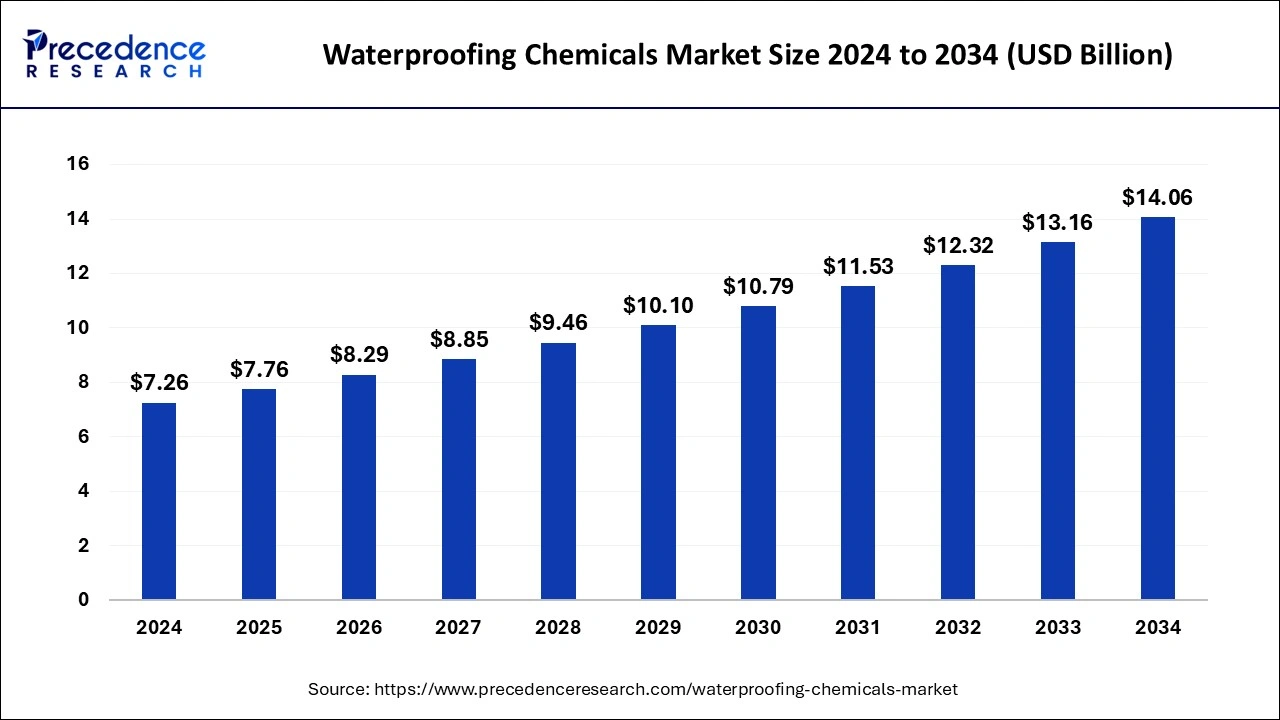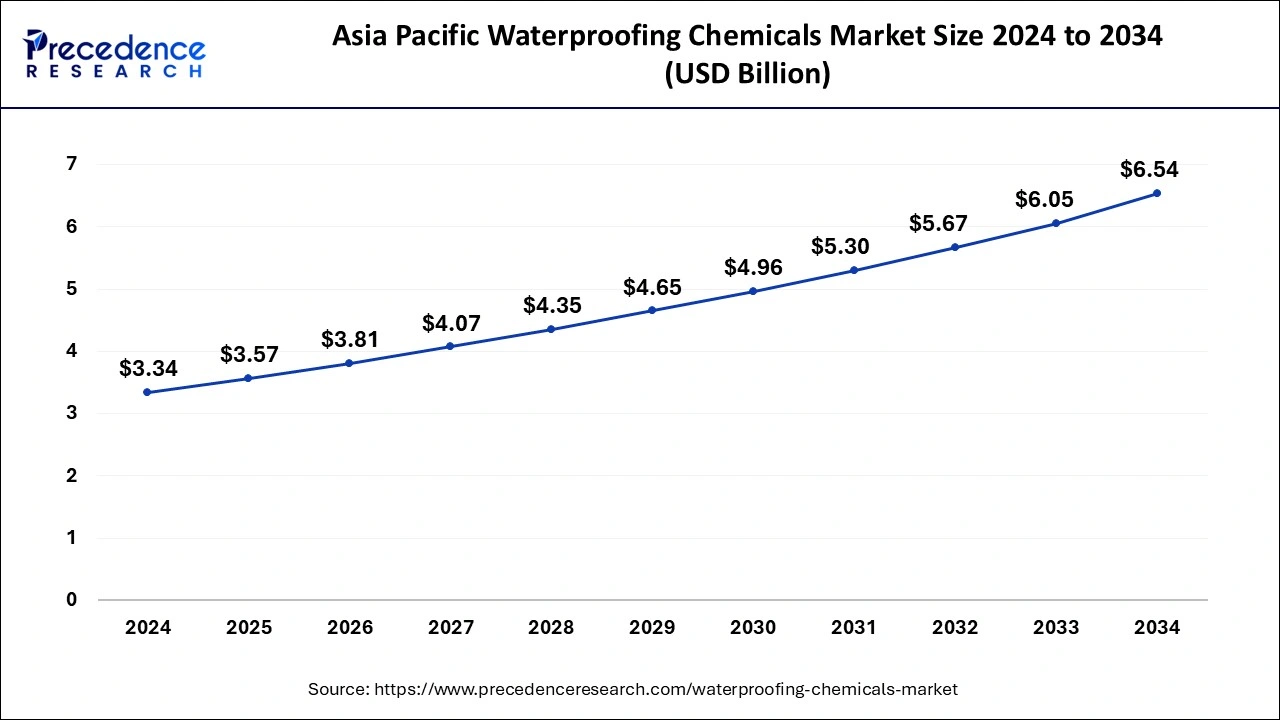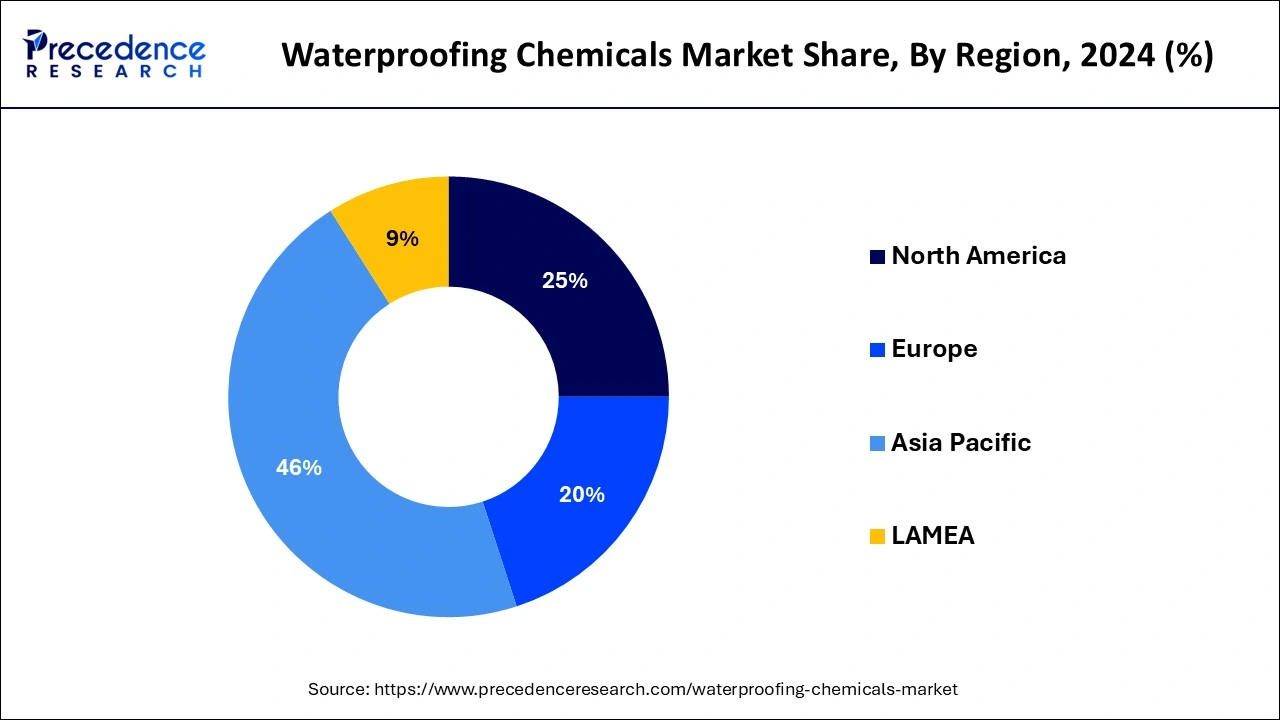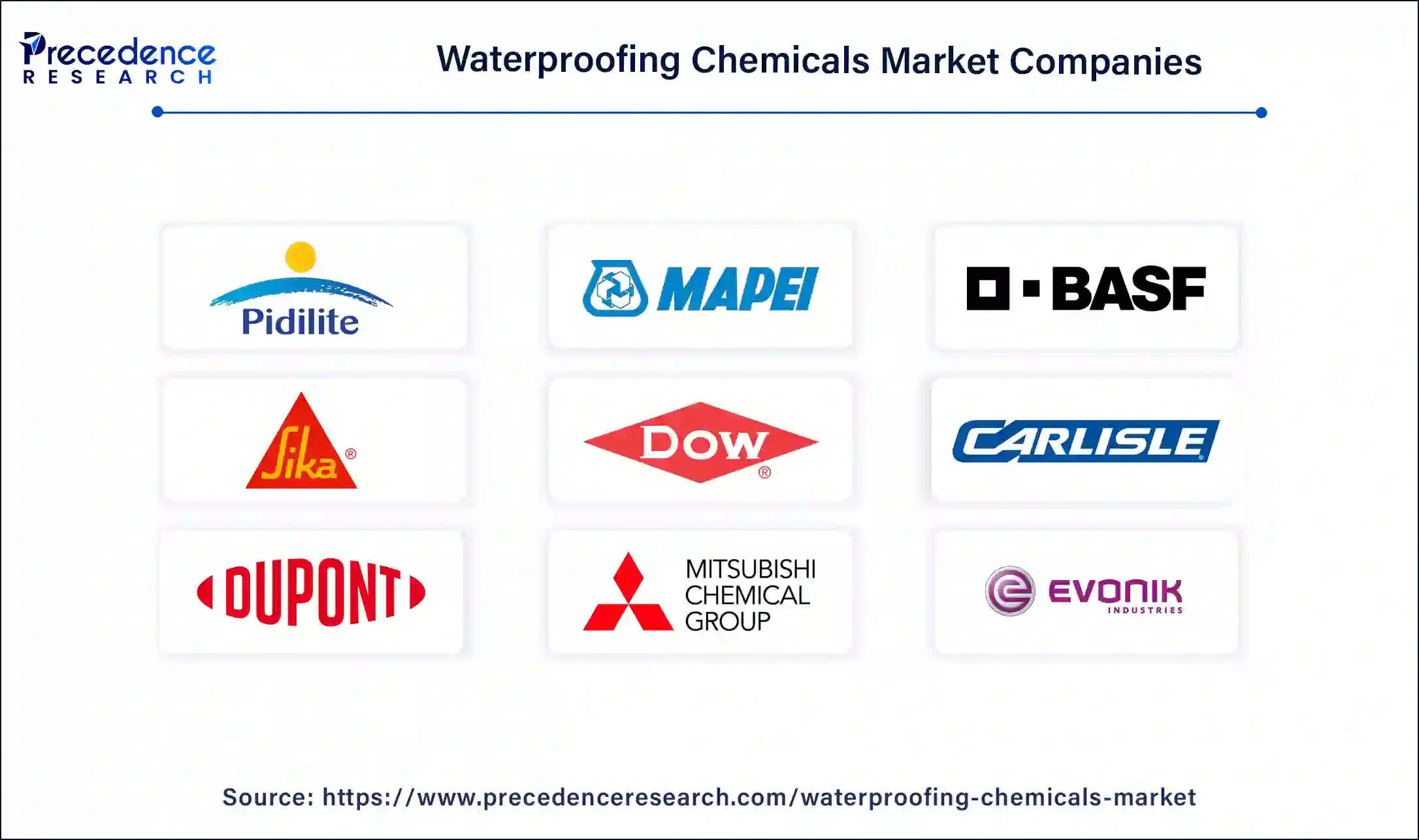January 2025
The global waterproofing chemicals market size is calculated at USD 7.76 billion in 2025 and is forecasted to reach around USD 14.06 billion by 2034, accelerating at a CAGR of 6.83% from 2025 to 2034. The Asia Pacific market size surpassed USD 3.34 billion in 2024 and is expanding at a CAGR of 6.95% during the forecast period. The market sizing and forecasts are revenue-based (USD Million/Billion), with 2024 as the base year.
The global waterproofing chemicals market size accounted for USD 7.26 billion in 2024 and is expected to exceed around USD 14.06 billion by 2034, growing at a CAGR of 6.83% from 2025 to 2034. The waterproofing chemicals market is growing as waterproofing agents maintain construction, protect buildings, and promote business. Improve the structural integrity and durability of buildings to increase health, comfort, and property value.

The integration of artificial intelligence (AI) and automation is having a greater impact on the waterproofing chemicals market. AI technology is used for predictive analysis to determine the best chemical ingredients and formulations for various environments. Automation in the manufacturing process increases efficiency, reduces waste, and improves product consistency, directly impacting manufacturing costs and competitiveness. In addition, artificial intelligence-driven analytics and machine learning algorithms can help companies better understand customer preferences and optimize their supply chains, ultimately leading to consumer interest and market penetration.
The Asia Pacific waterproofing chemicals market size was evaluated at USD 3.34 billion in 2024 and is projected to be worth around USD 6.54 billion by 2034, growing at a CAGR of 6.95% from 2025 to 2034.

Asia Pacific dominated the global waterproofing chemicals market in 2024. A large portion of the population is migrating from rural areas to cities, and cities are evolving into strong business, social, and innovation centers needed in recent years. The recent recovery in construction in many parts of Asia Pacific has led to increased demand for construction chemicals, including concrete and cement additives, asphalt modifiers, adhesives and sealants, flame retardants, waterproofing chemicals, and protective coatings. Many new projects in the Asia Pacific have been shelved due to rising construction costs and interest rates, as well as weak tenant demand.

North America is anticipated to host the fastest-growing waterproofing chemicals market in the coming years as construction in the U.S. is expected to grow rapidly. New residential construction increased, which was led by increases in two-family and multifamily housing. Building codes are the minimum design and construction standards required to ensure safe and efficient operation in North America. Infrastructure and land use are evolving in developing countries. There is an increasing awareness of environmental sustainability and the need for more energy-efficient products.
The waterproofing chemicals market is rapidly growing because waterproofing increases the overall strength and lifespan of structures, protecting them from water damage and corrosion. These chemicals prevent the wall from absorbing excess moisture, which reduces the risk of mold growth and prevents mold growth, which can be a health hazard. Waterproofing proves to be a cheap solution when compared to replacing the entire roof. It protects the site from water damage with minimal investment. Waterproofing solutions can instantly solve leakage problems, especially during rainy seasons.
The waterproofing chemicals market solutions protect homes and buildings from various water-related damages by providing better protection against moisture. Waterproofing is a material used to protect surfaces and equipment from damage by preventing water from entering. Used on many surfaces, such as concrete, these chemicals play an important role in maintaining the integrity of the structure, preventing mold growth, and ensuring the comfort of the home occupants. As people increase the aesthetics and efficiency of their homes, they are looking into various chemicals and coatings to achieve effective waterproofing.
| Report Coverage | Details |
| Market Size by 2024 | USD 7.26 Billion |
| Market Size in 2025 | USD 7.76 Billion |
| Market Size in 2034 | USD 14.06 Billion |
| Market Growth Rate from 2025 to 2034 | CAGR of 6.83% |
| Dominating Region | Asia Pacific |
| Fastest Growing Region | North America |
| Base Year | 2024 |
| Forecast Period | 2025 to 2034 |
| Segments Covered | and Regions |
| Regions Covered | North America, Europe, Asia-Pacific, Latin America, and Middle East & Africa |
Rising trends towards the protection of concrete structures
Waterproofing concrete slabs is essential to prevent moisture from penetrating, which can cause serious damage over time. This protection not only extends the life of concrete slabs but also saves money in the long run by reducing the need for costly repairs. Waterproofing also protects embedded steel bars from corrosion, a problem that occurs when metal is exposed to moisture. Since this corrosion can affect the strength and durability of the structure, waterproofing is essential to maintaining the integrity and durability of concrete. Sometimes, concrete is vulnerable to poor water quality due to its porous structure; the perceived need for good waterproofing solutions is driving demand for waterproofing solutions. This trend is driving significant growth in the waterproofing chemicals market as industries prioritize long-lasting, structurally sound infrastructure.
Rise of nanotechnology-based coatings
Nanotechnology opens up new ways to solve negative problems, and the integration of nanocoatings has advantages. The ceramic layer added with nanotechnology has hydrophobic and oleophobic properties, preventing the penetration of water, dirt, oil, and dry matter. Used on dry surfaces, this superhydrophobic coating does not alter its appearance, as the nanocoatings are essentially invisible. The molecular size of nanotechnology-based water repellents is typically less than 6-8 nm, allowing them to penetrate the pores of the substrate, creating a seamless and impermeable bond. This provides additional protection against liquids, dirt, corrosion, and rot and provides superior durability. The development of nanotechnology-based water repellents presents a major opportunity for the waterproofing chemicals market, where the industry is looking for high-performance, long-lasting solutions that beautifully combine aesthetics and functionality benefits.
High costs and maintenance challenges
The waterproofing chemicals market faces many constraints, primarily due to the significant cost associated with increasing efficiency. These costs include expensive materials, skilled workers, and sometimes excavation costs, especially when poor external drainage systems are used to access the foundation. In addition, some water systems do not work continuously, while some systems require regular maintenance and reuse, such as internal equipment deterioration, which increases maintenance costs over a long period. The sensitivity of some materials, such as bitumen, to temperature changes increases their performance because weather conditions can affect the results and make it possible for potential failures. These factors limit waterproofing solutions' widespread use and development because they increase initial and ongoing costs.
The bitumen-based segment held a significant share of the waterproofing chemicals market in 2024 due to its ability to withstand the worst weather conditions, such as high temperatures, rain, snow, ice, and freeze-thaw processes. Bitumen waterproofing membrane has a very long life, and despite aging, it maintains its flexibility and elasticity, making it an ideal roof. Bitumen-based waterproofing is very sticky and holds the materials tightly together. All these features prove that bituminous waterproofing is one of the most suitable solutions.
The polymer-based segment is expected to grow rapidly in the waterproofing chemicals market over the forecast period as the polymer waterproofing process provides consistent, long-term resistance to weathering, damage, and UV exposure. Its robust design ensures long-term water resistance, ensuring the longevity of the structure. Polymer waterproofing has become a popular and reliable method to solve water leakage problems in construction. It is the recommended choice for low water quality in many types of buildings due to its many uses and many advantages, such as adaptability, ease of application, and durability.
In 2024, the roofing segment led the global waterproofing chemicals market because good waterproofing is important if consumers want to extend the life of their flooring and increase the value of products. It is also cheaper than regular and frequent patching and repair of a leaky roof. Waterproofing will increase the sustainability and lifespan of the roof, as well as the value of the property or building.
The building structures segment will grow at the fastest rate in the waterproofing chemicals market during the studied years since waterproofing is essential to the entire construction and maintenance of a building. This will not only prevent water damage but will also prevent mold and bacteria from forming, which can cause other problems. Waterproofing during construction ensures overall durability by preventing water from damaging major components. It avoids unnecessary repair costs.

By Product
By Application
By Geography
For inquiries regarding discounts, bulk purchases, or customization requests, please contact us at sales@precedenceresearch.com
No cookie-cutter, only authentic analysis – take the 1st step to become a Precedence Research client
January 2025
April 2025
January 2025
May 2024